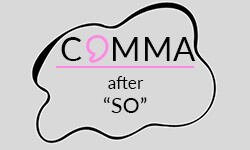
The correct usage of commas in academic writing is a crucial punctuation rule in English grammar. It helps clarify sentence structure and conveys different meanings. Whether signaling a result, cause, or emphasis, mastering this comma usage is essential for effective communication and writing clarity. This article will shed a light on the rules and examples of how to use a comma after “so”.
When to place a comma after “so”
Normally, there is no need for a comma after “so”, or even before it. Just like other conjunctions, it is immediately followed by the clause it introduces. As a meaningless interjection (common in everyday speech) you can, but you don’t have to put a comma before or after “so”. It depends on whether there’s a natural pause at that point in the sentence. Enclosed you will find explanatory examples:
Comma
“So” in introductory clauses
“So” as a pause for emphasis
No comma
“So” in cause-effect-relationship
“So” as an adverb of degree
However, if you’re still not sure which one to use, try to replace “so” with either “therefore” or “so that” and see which one better fits your meaning. Different style guides may present varying rules about comma usage, and certain complex sentences might deviate from conventional comma placement guidelines. It’s essential to assess the necessity of a comma to ensure the clarity and completeness of your sentence.
Comma after “so”
When “so” functions as a parenthical element or coordinating conjunction connecting two independent clauses and is used to mean “therefore” or “for that reason”, a comma is always needed.
“So” in introductory clauses
A comma is typically placed after “so” in introductory clauses. When “so” is used at the beginning of a sentence to introduce an adverbial clause, it’s common to place a comma after it.
When “so” can be replaced with the term “therefore” or “as a result”, you should use a comma before “so”.
“So” as a pause for emphasis
A comma can be used after “so” to create a pause for emphasis or to set off a particular word or phrase. This is often used in everyday speech, depending on whether there’s a natural pause at this point of the sentence, or not. Below you’ll find examples:
No comma after “so”
When you use “so” instead of “so that” or “in order that”, it’s called a subordinating conjunction. It connects an independent clause with a dependent clause. In everyday speech it is often used as a meaningless interjection where a comma can, but doesn’t necessarily have to be placed, depending on whether there is a natural pause in the sentence or not. However, there’s normally no need or specific rule for a comma after “so”.
“So” in a cause-effect-relationship
When “so” is used in a short sentence to express a clear cause-effect-relationship, a comma is not necessary.
Test yourself!
Practice sheet
To see how well you understand using commas after “so”, try placing them in the right places in 10 sentences. Once you’re ready, check your answers in the second tap to make sure you have the correct understanding.
- So are you coming to the party tonight?
- Naomi was hungry so she made herself a sandwich.
- So we meet again.
- I was so tired yesterday!
- She was feeling unwell so she decided to take the day off.
- So you’ve decided to join us for dinner.
- She drove fast so that she wouldn’t be late.
- So what’s the plan for tomorrow?
- I will study everyday so I can pass the exam.
- So it turns out she is an expert on the subject.
- So, are you coming to the party tonight? (Comma)
- Naomi was hungry, so she made herself a sandwich. (Comma)
- So we meet again. (No comma)
- I was so tired yesterday! (No comma)
- She was feeling unwell, so, she decided to take the day off. (Comma)
- So you’ve decided to join us for dinner. (No comma)
- She drove fast so that she wouldn’t be late. (No comma)
- So, what’s the plan for tomorrow? (Comma)
- So many books to read and so little time. (No Comma)
- So, it turns out she is an expert on the subject. (Comma)
- ✓ Free express delivery
- ✓ Individual embossing
- ✓ Selection of high-quality bindings
FAQs
When “so” starts a sentence and is followed by an independent clause, it is often separated from the rest of the sentence with a comma for clarity. For example: “So, I decided to buy a house.”
No. When “so” connects two independent clauses and is used to mean “therefore”, the comma should come before “so”, not after it.
Yes, you can use a comma both ways, either before or after “so”, to create a stronger pause for emphasis. This is especially common in informal writing and in cases where you want to draw particular attention to what follows “so”.
